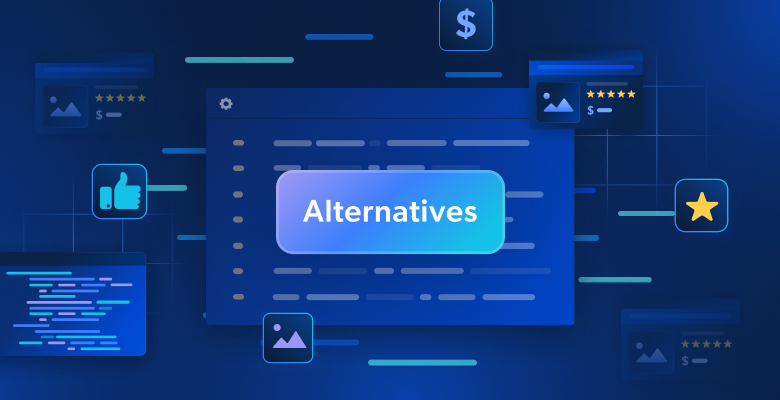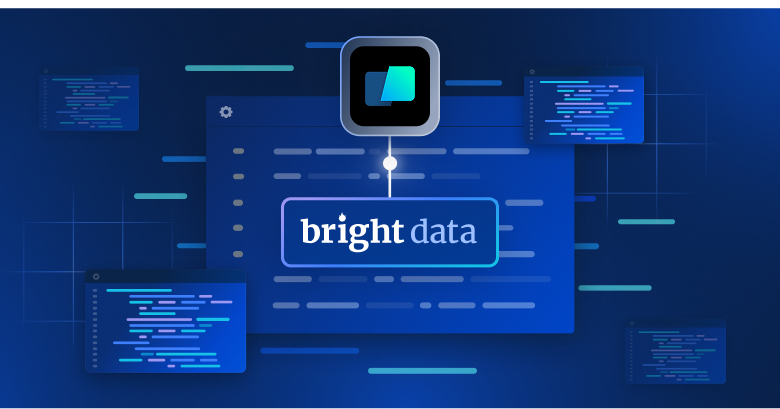From autonomous research assistants to agents that manage entire workflows, AI agents are quickly becoming more than just a trend; they’re shaping the future of work, development, and decision-making. But behind every capable agent is a carefully constructed tech stack, a layered system of tools that enables these agents to reason, act, and adapt.
What’s Powering the Next Generation of Automation
For developers, understanding this stack is essential. It’s not just about which tools are trending, it’s about how they work together, where the real value lies, and what foundational elements must be in place for agents to perform reliably.
At Bright Data, we work with AI teams across industries, and one thing is clear: every agent starts with data. In this article, we’ll walk through the core layers of the AI agent tech stack starting with the most critical: Data Collection & Integration.
Data Collection & Integration
The First Step in Building Smarter Agents
Before an AI agent can reason, plan, or act, it needs to understand the world it operates in. That understanding starts with data real-world, real-time, and often unstructured. Whether it’s training a model, powering a retrieval-augmented generation (RAG) system, or enabling an agent to respond to live market changes, data is the fuel.
This is where Bright Data comes in.
We provide the infrastructure that lets AI teams tap into the public web at scale, with precision, and in compliance. Our tools are designed to make data collection not just possible, but seamless.
Bright Data’s Role in the Stack
- Search API – Surfaces relevant web content in real time, ideal for RAG and LLM-enhanced search.
- Unlocker API – Bypasses anti-bot protections to ensure reliable access to public data sources.
- Web Scraper API – Extracts structured data from over 120,000 websites, ready for immediate use.
- Custom Scraper – Tailored solutions for niche verticals and specific agent needs.
- Dataset Marketplace – Pre-collected datasets for fast prototyping or model fine-tuning.
- AI Annotations – Human-in-the-loop services for labeling and refining training data.
“If AI agents are the brains, Bright Data is the eyes.”
Use Case: E-commerce Intelligence Agent
A retail company builds an AI agent to monitor competitor pricing and product availability. Using Bright Data’s Web Scraper API and Unlocker API, the agent collects real-time data from competitor sites and feeds it into a pricing engine that adjusts offers dynamically.
AI Agent Full Techstack

Agent Hosting Services
Where AI Agents Come to Life
Once an agent has access to data, it needs a place to operate a digital environment where it can reason, make decisions, and take action. That’s the role of agent hosting services: they provide the infrastructure that turns static models into dynamic, autonomous systems.
These platforms manage everything from orchestration to execution and ensure agents can scale, interact with APIs, and operate continuously.
What Developers Are Using
- LangGraph – A graph-based runtime for building stateful, multi-step agent workflows.
- Hugging Face Inference Endpoints – Hosts and serves models and agents, with tools like Transformers Agents for real-time interactions.
- AWS (Bedrock, Lambda, SageMaker) – Offers flexible, scalable infrastructure for deploying and managing agents at scale.
Hosting platforms are the operating systems of the agent world but even the best-hosted agent is only as good as the data it’s built on.
Observability
Making AI Agents Transparent, Traceable, and Trustworthy
As agents become more autonomous, the need to understand what they’re doing and why becomes essential. Observability tools help developers monitor performance, trace decisions, and debug issues in real time.
What Developers Are Using
- LangSmith (LangChain) – Traces, debugs, and evaluates LLM-powered workflows.
- Weights & Biases – Tracks model performance, experiments, and agent behavior over time.
- WhyLabs – Monitors data drift and model anomalies in production environments.
Observability turns agents from black boxes into glass boxes, giving developers the visibility they need to build trust and iterate safely.
Agent Frameworks
The Blueprints for Building Smarter, More Capable Agents
Frameworks define how agents are structured, how they reason, interact with tools, and collaborate with other agents. As agent complexity grows, frameworks are evolving to support multi-agent systems, task decomposition, and dynamic planning.
What Developers Are Using
- Crew AI – Enables teams of agents to collaborate, each with defined roles and responsibilities.
- LangGraph – Supports branching logic and stateful workflows for complex agent behavior.
- DSPy – A declarative framework for optimizing and fine-tuning LLM pipelines.
Frameworks give agents their structure and logic, but they rely on accurate, real-time data to function effectively.
Memory
How Agents Remember, Learn, and Stay Context-Aware
Memory systems allow agents to retain context, recall past interactions, and build long-term understanding. Typically powered by vector databases, memory is essential for personalization, continuity, and complex reasoning.
What Developers Are Using
- ChromaDB – Lightweight and ideal for local-first development.
- Qdrant – Scalable, production-ready vector search with hybrid filtering.
- Weaviate – Modular and ML-friendly, often used in enterprise-grade deployments.
Memory enables agents to learn and adapt, but it’s only as useful as the data it stores again, reinforcing the need for high-quality input from the start.
Tool Libraries
How Agents Take Action in the Real World
Tool libraries give agents the ability to interact with external systems APIs, databases, search engines, and more. This is what turns language models into actionable agents.
What Developers Are Using
- LangChain – A robust ecosystem for chaining LLMs with tools, memory, and workflows.
- OpenAI Functions – Allows agents to call external tools directly from within GPT models.
- Exa – Enables real-time web search, often used in research agents and RAG systems.
Tool libraries are what make agents useful, but their effectiveness depends on the quality of the data they interact with.
Sandboxes
Where Agents Safely Execute Code and Test Ideas
Agents increasingly need to write and run code whether for data analysis, simulations, or dynamic decision-making. Sandboxes provide safe, isolated environments for doing just that.
What Developers Are Using
- OpenAI Code Interpreter – Executes Python securely within GPT-4 for data-heavy tasks.
- Replit – A cloud-based coding environment with AI integration.
- Modal – Serverless infrastructure that doubles as a secure code execution layer.
Sandboxes let agents reason through problems and generate actionable outputs but again, the quality of those outputs depends on the quality of the inputs.
Model Serving
The Second Brain: Where Decisions Are Made
If data is the first brain of the AI agent, what agents know then model serving is the second way they think.
This is where LLMs are hosted and accessed, providing the reasoning and language generation that powers every agent decision. The performance, latency, and accuracy of this layer directly impact the agent’s effectiveness.
What Developers Are Using
- OpenAI (GPT-4, GPT-4o) – Industry standard for general-purpose reasoning and multimodal capabilities.
- Anthropic (Claude) – Known for long context windows and alignment-focused design.
- Mistral – Open-weight models offering high performance at lower cost.
- Groq – Ultra-low latency inference for real-time agent responses.
- AWS (SageMaker, Bedrock) – Scalable infrastructure for serving both proprietary and open models.
Model serving is where insight becomes action but even the best models need high-quality, real-time data to reason effectively.
Storage
Where Agents Keep Their History, Knowledge, and State
Storage systems support long-term persistence logging interactions, saving outputs, and maintaining state across sessions. They’re essential for reproducibility, compliance, and continuous improvement.
What Developers Are Using
- Amazon S3 – The go-to for scalable object storage.
- Google Cloud Storage (GCS) – Secure and integrated with Google’s AI tools.
- Vector DBs (e.g., Qdrant, Weaviate) – Store embeddings and semantic context for retrieval.
Storage ensures agents can learn from the past and scale over time but the value of what’s stored starts with the quality of what’s collected.
Your Agents Are Only as Smart as Their Data
AI agents are only as capable as the information they’re built on. They can reason, plan, and act but only if they have access to the right data at the right time. Without that, even the most sophisticated tech stack becomes a closed loop: powerful, but disconnected from the real world.
That’s why data isn’t just one part of the stack, it’s the foundation. And in today’s AI ecosystem, the most valuable data source is the public web.
At Bright Data, we make that data accessible.
Our tools power the first and most critical step in the AI agent workflow: data collection and integration. We connect agents to the public web in real time providing the structured, reliable, and scalable data they need to understand the world, make informed decisions, and take meaningful action.
Every layer of the tech stack agent frameworks, memory systems, tool libraries, model serving depends on that foundation. Because without accurate, up-to-date information, agents can’t adapt, personalize, or perform.
In a sense, your agents have two brains:
- The data; what they know.
- The model; how they think.
Before your agents can act, they need to understand.
Before they can understand, they need to see.
Bright Data is how they see the world.
Next Step
Explore how Bright Data can power your AI agent stack: https://brightdata.com/ai/products-for-ai







